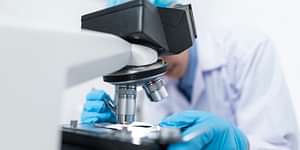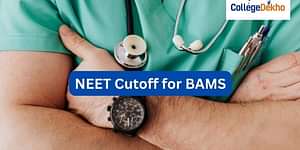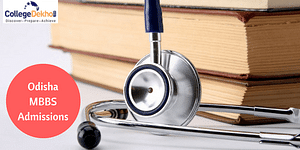BAMS Course: Full Form, Admission, Eligibility, Syllabus, Top Colleges Syllabus & Subjects 2024
BAMS Syllabus & Subjects Overview
BAMS syllabus has been designed to impart extensive knowledge of ayurvedic medical science to the aspirants. The primary aim of the BAMS syllabus is to train the candidates to pursue a career in ayurvedic science and surgery which consists of job roles such as ayurvedic doctors, panchakarma doctors, therapists, pharmacists etc. BAMS Course is a 5.5 year long undergraduate programme for medical students interested in exploring the field of ayurveda. The course also includes a mandatory 12 month period of internship.
BAMS Syllabus has been curated to provide both theoretical as well as practical knowledge of ayurveda to the students. Therefore, the course curriculum includes theoretical subjects such as Ayurveda Nirupana, Dravya, Pratyaksha Pariksha, Mishraka Gana etc along with practical subjects such as study of bones and organs. Candidates who develop a thorough understanding of the BAMS Syllabus curriculum can easily find employment opportunities in hospitals, clinics, health centers and state dispensaries. Students who wish to pursue a career in ayurvedic science and surgery must acquaint themselves with the wide range of disciplines taught in the course.
Table of Contents
- BAMS Syllabus & Subjects Overview
- Important BAMS Course Syllabus Facts
- BAMS Course Syllabus Year-wise
- BAMS Course Specializations
- List of Core Subjects in BAMS Course Syllabus
- BAMS Syllabus: Practical Subjects
- BAMS Top Colleges
- Best Books for BAMS Syllabus
- BAMS Syllabus: Preparation Tips
- BAMS Syllabus Course Projects
- BAMS Teaching Methodology and Techniques
Important BAMS Course Syllabus Facts
Mentioned below are some of the interesting facts about BAMS Course Syllabus that every interested candidate should know of, prior to applying for the BAMS Course Admission:
- BAMS Course Syllabus comprises a mandatory internship for 1 year in the 5th year of the entire course. All students are required to participate in the internship program as a part of the course curriculum.
- The structure of BAMS Course syllabus is uniform across all colleges, and designed by the Central Council of Indian Medicine (CCIM).
- BAMS Course Syllabus also includes a list of practical training, Projects, Lab exercises and experiments.
BAMS Course Syllabus Year-wise
The BAMS Course has been divided into 4 Years. In each year, students are taught different subjects to prepare them to treat patients using the techniques and practices of ayurvedic science. Moreover, students have the opportunity to dig deep in the field of ayurvedic medicines that can cure diseases and provide relief to patients. Therefore, the course curriculum for BAMS has been mentioned below for students to glance through:
| Year | Subjects |
|---|---|
| Year 1 | Ayurveda Nirupana, Dravya Vigyan Niyam, Pratyaksha Pariksha, Anumanapariksha, Pariksha and Samavaya Vigyanam |
| Year 2 | Dravya, Vyadhi Vigyan, Mishraka Gana, Diseases of Rasa Vaha Srotas, Basic Pathology, Hematology and Prabhava |
| Year 3 | Ritucharya, Epidemiology, Janapadodhwamsa, Garbha Vigyana Dinacharya, Preventive Geriatrics and Pancha Kosha Theory |
| Year 4 | Snehana, Physiotherapy, Virechana Karma, Marma Nirjantukarana , Kshara and Kshara Karma, Bhya Snehana |
BAMS Course Specializations
There are a large number of specializations available in the BAMS Course. Candidates can choose to pursue any of these specializations as it opens up the spectrum of job opportunities available for them. Moreover, candidates with a particular specialization in the BAMS Course are likely to be preferred over the other applicants. Thus, mentioned below is the detailed insight of all the specializations that BAMS aspirants can pursue:
| Specialization | Details |
|---|---|
Padartha Vigyan
| This subject deals with the metaphysical aspects of ayurvedic science and surgery. |
Prasuti and Stri Roga
| This branch of ayurvedic science explores the field of obstetrics and gynecology. |
Sharir Kriya
| This subject deals with the study of the human body, mind and senses. |
Charak Samhita
| This is one of the oldest ayurvedic subjects and deals with the treatment of the human body, soul and mind. |
Sharir Rachana
| This branch of ayurvedic science takes a deep dive into the structure of the human body. |
| Kayachikitsa | This subject deals with the general medicines for the treatment of the body. |
Rasa Shastra
| In this subject students learn how the various metals and minerals such as mercury are used to treat the illnesses amongst patients. |
KaumaraBhritya
| This branch of ayurvedic science deals with the care of child right from the birth till it attains the age of 16 years. |
Agad Tantra
| This subject deals with the study of poison, its impact and remedy or treatment. |
Shalakya Tantra
| This branch of ayurvedic science teaches about the diagnosis and management of diseases occurring above the clavicle. |
Swasthavritta Rog Vikriti Vigyan | In this subject students learn to understand any particular disease as well as provide the diagnosis. |
List of Core Subjects in BAMS Course Syllabus
The core BAMS Course subjects are mentioned below in the table:
| Subject Title | Details |
|---|---|
| Kriya Sharir | This particular subject includes topics such as Doshas, Prakriti, Ahara, Physiology of body systems, Dhatus, Malas. |
| Dravyaguna Vigyan | This particular subject includes topics such as Rasa, Karma, Mishraka Gana, General information on pharmacology, Dravyas, Annapana Varga. |
| Rachana Sharir | This particular subject includes topics such as Shariropkramaniya Shaarira, Garbha Shaarira, Embryology, Surface and radiological anatomy, Sira, Dhamani, Srotas Shaarira, Koshtha Evam Ashaya Shaarira. |
| Roga Nidana | This particular subject includes topics such as |
| Padartha Vigyan and Ayurveda Itihas | This particular subject includes topics such as Ayurveda Nirupana, Dravya Vigyaniyam, Gunavigyaniyam, Samanya Vigyaniyam, Karya-Karana Siddhanta, Globalisation of Ayurveda. |
BAMS Syllabus: Practical Subjects
To provide hands-on experience to the aspirants, BAMS Course Curriculum includes a variety of practical subjects pertaining to the field of ayurvedic science. Therefore, a list of all the practical subjects in the four years of the course has been mentioned in the table below:
| Year | Practical Subjects |
|---|---|
| Year 1 | Ayurveda Practical, Modern Physiology Practical, Study of Bones and Organs, Shava Vichhedana |
| Year 2 | Study of the Microscopic and Macroscopic characters of Stem & Leaves, Fundamental Principles of Laboratory Tests and Hematology |
| Year 3 | Clinical exposure to care for Newborn, Vaccination and Blood Sampling, Post Mortem, Clinical Posting, Evidence in Court, Demonstration of Dinacharya procedures, Clinical training-obstetric skills and Gynecological Skills |
| Year 4 | Patient Examination, Identification and usage of different Surgical tools, Identification and utility of surgical instruments, Sterilization, Para-surgical training procedure, Observation of OPD patients, IPD (Panchkarma) and Panchakarma Unit and Bedside Clinicals |
BAMS Top Colleges
There are a large number of medical colleges that offer admissions to BAMS Course. NEET UG is the most widely accepted Entrance Exam for BAMS Admissions. Students must secure the same or more than the announced NEET UG Cutoff in order to apply for BAMS Admissions. Therefore, a list of all the top colleges in India that offer BAMS Admissions along with their admission fees has been mentioned in the table below:
| College Name | BAMS Admission Fees |
|---|---|
| Banaras Hindu University | INR 10,000 |
| Sri Chandrasekharendra Saraswathi Viswa Mahavidyalaya (SCSVMV) | INR 15 LPA |
| Rajiv Gandhi Institute of Health Sciences | INR 14,000 |
| Ashokrao Mane Ayurvedic Medical College Hospital and Research Centre | INR 6 LPA |
| Uttarakhand Ayurved University | INR 1.5 LPA |
| Bundelkhand Government Ayurvedic College and Hospital, Jhansi | INR 80,000 |
| Government Akhandanand Ayurved College, Ahmedabad | INR 18,000 |
| Maharashtra University of Health Sciences | INR 1.15 LPA |
| Government Ashtang Ayurved College, Indore | INR 2.5 LPA |
| Ayurvedic and Unani Tibbia College | INR 10,000 |
| DR. Y.S.R University Of Health Sciences | INR 45,000 |
| Baba Kheta Nath Government Ayurvedic College and Hospital, Narnaul | INR 85,000 |
Best Books for BAMS Syllabus
In order to score well in the BAMS Exams, students must refer to the books that cover all the aspects of the BAMS course curriculum. In addition to the books and material prescribed by the universities, students can look for reference books published by renowned authors to have a better understanding of the BAMS Syllabus. Therefore, some of the best reference books have mentioned in the table below for the students to glance through:
| Book | Author |
|---|---|
| A Textbook of Kayachikitsa (Vol. 1-3) | Dr. Sunanda Ranade |
| Ayurveda: A Quick Reference Handbook | Manisha Kshirsagar. Dr and Ana Cristina R. Magno |
| Ayurveda and Panchakarma: The Science of Healing and Rejuvenation | Sunil V. Joshi |
| Ayurvediya Panchakarma Chikitsa – Vijnana | Vijay Kumar Rai |
| Dravyaguna Vijnana 5 Volume Set | Dr. J. L. N. Sastry and Mrs. J. V. R. Lakshmi |
| Textbook Of Swasthavritta | Dr. Bargale Sushant Sukumar |
| Ayurvedic Physiology ( Sharir Kriya Vijnana) | Prof. S. B. Kotur and Dr. Shashikala Kotur |
| Sarngadhara-Samhita – A Treatise on Ayurveda | Prof. K. R. Srikantha Murthy |
| Dravyaguna Vijnana 5 Volume Set | Dr. J. L. N. Sastry and Mrs. J. V. R. Lakshmi |
BAMS Syllabus: Preparation Tips
The BAMS Course Curriculum is extensive, and it calls for frequent practice of the material being covered in class. In order to do well in exams by thoroughly studying the BAMS Course Syllabus, students must refer to the preparation tips that have been mentioned below:
- It is advisable to start preparing the BAMS Syllabus for the exams right from the beginning of each semester.
- Students must ensure that they pay careful attention to what is being taught in class. Careful attention ensures that students understand the BAMS subject topics better and this assists them greatly when they appear for the exams.
- In addition to the books prescribed by the college authorities, always look out for BAMS reference books. Read through the books and make notes of the topic which you feel is important for the exams.
- While studying for long hours is the key to score well, taking frequent breaks to relax the mind is equally important. Ensure that you take breaks at frequent intervals.
BAMS Syllabus Course Projects
BAMS Syllabus course projects are required to be submitted by the students during their course duration for practical learning of theoretical topics. BAMS Syllabus projects are designed to assist students in getting hands-on experience, and training to acquire skills for managing medical work. BAMS syllabus projects are to be completed by the end of the fourth professional year. Some of the popular BAMS Syllabus project topics are listed below:
- Documentation and validation of traditional activities, and folklore in connection with human and veterinary use
- Examination of Medical and Ayurveda explanations in non-Ayurveda literature such as Vedas, Puranas, Samhitas, Sanskrit literature, and so forth
- Specific diseases and study of Shat Kriya Kala. Establishing a correlation in the clinical, Pathological and Biochemical and Immunological, and Molecular markers
- Analysis of drug and drug interaction between Ayurvedic drugs and Allopathic drugs
BAMS Teaching Methodology and Techniques
The BAMS syllabus includes theoretical classroom-based teaching and internship work to understand the concepts of Ayurveda effectively. Students learn through projects, seminars, and assignments during the course duration of 5.5 years. Listed below are the teaching methodology and strategies for the BAMS Syllabus in general:
- Group Projects
- Traditional Classroom-Based Teaching
- Practical Lab Sessions
- Talks from guest speakers
- Seminars
- Internships


















